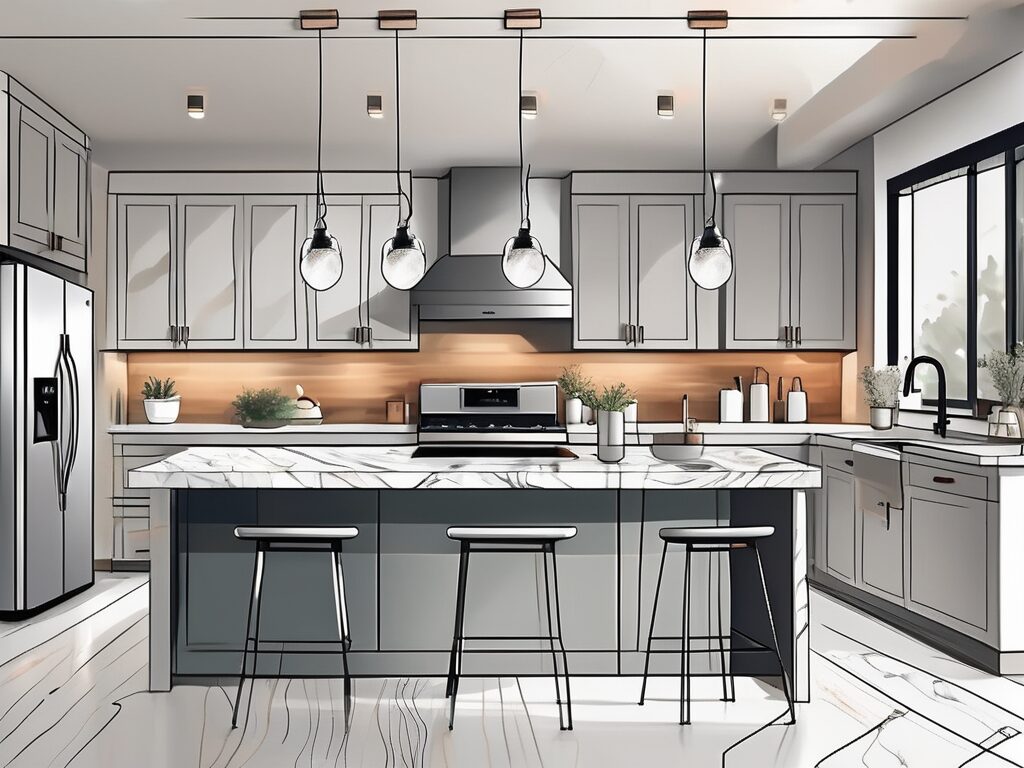
Agent A-Team or Solo Superhero? Finding the Right Real Estate Partner for Your Selling Journey in Wildwood Florida
When it comes to selling your home in Wildwood, Florida,…
January 29, 2024
Remodeling your kitchen can be an exciting and transformative project for homeowners. Not only does it refresh the look and feel of your home, but it can also increase its value and functionality. However, before embarking on a kitchen remodel, it’s important to have a clear understanding of the costs involved. This comprehensive guide will provide you with all the information you need to make informed decisions about your kitchen remodeling project in 2022.
When it comes to kitchen remodeling costs, there are several factors to consider. These include the size of your kitchen, the extent of the renovation, the materials you choose, and whether you hire professionals or opt for a DIY approach.
Remodeling your kitchen can be an exciting and transformative project. It not only enhances the functionality and aesthetics of your space but also adds value to your home. However, before diving into the world of kitchen remodeling, it’s essential to have a clear understanding of the costs involved.
Let’s take a closer look at the breakdown of average kitchen remodeling costs to help you plan your project effectively.
On average, homeowners spend between $12,594 and $35,664 on kitchen remodeling projects. This cost range includes expenses such as labor, materials, appliances, and permits. However, it’s important to note that these figures can vary widely depending on the scope of your project and the choices you make.
When determining the budget for your kitchen remodel, it’s crucial to consider your specific needs and goals. Are you looking for a simple facelift or a complete overhaul? Do you want to incorporate high-end finishes or stick to a more budget-friendly approach? These factors will significantly impact the overall cost of your project.
For example, a minor kitchen remodel that focuses on cosmetic improvements and small upgrades can cost between $10,000 and $15,000. This type of renovation may include repainting the walls, replacing the cabinet hardware, upgrading the faucet, and installing new light fixtures. It’s a cost-effective way to give your kitchen a fresh new look without breaking the bank.
On the other hand, a major kitchen remodel that involves structural changes and high-end finishes can easily exceed $50,000. This type of renovation may include knocking down walls to create an open-concept layout, installing custom cabinetry, upgrading to top-of-the-line appliances, and installing luxurious countertops and backsplashes.
It’s important to carefully consider your budget and priorities when deciding on the scale of your kitchen remodel. By setting realistic expectations and understanding the potential costs, you can make informed decisions that align with your vision and financial capabilities.
When determining the scale of your kitchen remodel, it’s crucial to consider both your budget and your long-term goals. Ask yourself how much you’re willing to invest and what you hope to achieve with the renovation. This will help you prioritize your expenses and make sound decisions that align with your vision.
Keep in mind that even small changes can make a big difference. For instance, updating your kitchen cabinets, countertops, or lighting fixtures can give your space a fresh new look without breaking the bank. These minor upgrades can significantly impact the overall aesthetic and functionality of your kitchen.
Additionally, consider the layout and flow of your kitchen. If you’re looking to improve the functionality and create a more efficient workspace, you may need to invest in structural changes such as removing walls or reconfiguring the layout. While these changes can be more costly, they can also have a significant impact on the overall usability and value of your kitchen.
Ultimately, the right scale for your kitchen remodel depends on your unique needs, preferences, and budget. By carefully considering these factors and consulting with professionals, you can create a plan that maximizes your investment and brings your dream kitchen to life.
One of the primary concerns for homeowners is getting the best return on their investment. While it’s important to create a kitchen that you love, it’s also wise to consider the potential impact on your home’s resale value.
When it comes to maximizing your return on investment (ROI), there are several factors to consider. One of the most important is the choice of materials. Opting for high-quality materials can not only enhance the aesthetic appeal of your kitchen but also increase its durability and longevity. For example, investing in solid wood cabinets instead of particleboard can make a significant difference in the overall value of your kitchen.
In addition to materials, the layout and functionality of your kitchen play a crucial role in its resale value. Consider the flow of the space and how well it caters to the needs of potential buyers. A well-designed kitchen with ample storage, efficient work areas, and easy access to appliances can greatly appeal to buyers and increase the value of your home.
To ensure a high return on investment, focus on projects that offer both aesthetic appeal and practical functionality. Upgrading appliances is a popular choice that can attract potential buyers. Energy-efficient fixtures, such as LED lighting and low-flow faucets, not only reduce utility costs but also appeal to eco-conscious buyers.
Another area to consider is storage solutions. Adding custom-built cabinets, pantry organizers, and pull-out shelves can greatly enhance the functionality of your kitchen and make it more appealing to buyers. A well-organized and clutter-free kitchen is highly desirable and can significantly increase the value of your home.
Creating a realistic budget is crucial for a successful kitchen remodel. Start by researching the costs of materials and labor in your area, and then allocate your funds accordingly. Leave some wiggle room for unexpected expenses or upgrades that you may decide to pursue along the way.
It’s also worth exploring cost-saving options, such as utilizing recycled materials or shopping during sales and promotions. For example, you can consider salvaging vintage fixtures or repurposing old furniture to add unique character to your kitchen while staying within your budget. Remember, a well-planned budget can help you make the most out of your kitchen remodeling project.
While some homeowners prefer a DIY approach, hiring a professional kitchen designer can be a worthwhile investment. These experts have the knowledge and experience to create a functional and aesthetically pleasing space that maximizes your budget and meets your specific needs.
A professional designer can help you navigate through the myriad of choices, from selecting the right materials and finishes to optimizing the layout for optimal functionality. They can also provide valuable insights and suggestions that you may not have considered, ultimately adding value to your kitchen remodel.
It’s important to anticipate and plan for unexpected expenses that may arise during your kitchen remodel. As with any home improvement project, there can be unforeseen issues that require additional repairs or adjustments. Setting aside a contingency fund can provide peace of mind and help you tackle unexpected challenges without derailing your project.
Additionally, it’s essential to factor in the cost of permits and inspections, which are often required for major kitchen renovations. These expenses can vary depending on your location and the scope of your project, so be sure to include them in your budget to avoid any surprises along the way.
While it’s impossible to predict the exact impact a kitchen remodel will have on your home’s resale value, it’s worth considering how certain choices might appeal to potential buyers. Neutral colors, timeless designs, and quality materials tend to have broader appeal and can contribute to a higher resale value.
When selecting colors and finishes, opt for a neutral palette that can easily adapt to different styles and preferences. This allows potential buyers to envision themselves in the space and makes it easier for them to personalize it to their liking.
Furthermore, consider the long-term trends in kitchen design. While it’s tempting to follow the latest fads, they may quickly become outdated, potentially diminishing the value of your kitchen. Instead, focus on classic and timeless designs that have proven to withstand the test of time.
Ultimately, maximizing your return on investment requires careful planning, smart spending, and thoughtful consideration of the potential impact on your home’s resale value. By making informed choices and investing in quality materials and design, you can create a kitchen that not only brings you joy but also adds significant value to your home.
If the cost of a kitchen remodel is beyond your immediate budget, don’t worry. There are various financing options available to homeowners.
Depending on your situation, you may qualify for home equity loans, personal loans, or lines of credit. It’s important to carefully evaluate the terms, interest rates, and repayment schedules of these options to determine the best fit for your financial circumstances.
One popular financing option for homeowners is a home equity loan. This type of loan allows you to borrow against the equity you have built up in your home. The amount you can borrow is typically based on the appraised value of your home, minus any outstanding mortgage balance. Home equity loans often have lower interest rates compared to other types of loans because they are secured by your property. However, keep in mind that defaulting on a home equity loan could result in the loss of your home.
Another financing option to consider is a personal loan. Personal loans are unsecured loans, meaning they are not backed by collateral such as your home or car. These loans are typically based on your creditworthiness and income. Personal loans can be a good choice if you don’t have a lot of equity in your home or if you prefer not to use your home as collateral. However, keep in mind that personal loans usually have higher interest rates compared to home equity loans.
If you prefer more flexibility in your financing, a line of credit may be the right option for you. A line of credit is a revolving credit account that allows you to borrow up to a certain limit. You can use the funds as needed and only pay interest on the amount you borrow. Lines of credit can be secured or unsecured, depending on the lender and your creditworthiness. They can be a convenient option for ongoing home improvement projects, as you can borrow and repay multiple times within the credit limit.
When exploring financing options, it’s important to consider the terms and conditions of each option. Look for competitive interest rates, reasonable repayment schedules, and any additional fees or charges. It’s also a good idea to shop around and compare offers from multiple lenders to ensure you’re getting the best deal.
Before making a decision, take the time to evaluate your current financial situation and determine how much you can comfortably afford to borrow. Consider factors such as your income, existing debts, and other financial obligations. It’s important to choose a financing option that fits within your budget and won’t strain your finances.
Remember, financing a remodel is a big decision, and it’s essential to make an informed choice. Take the time to research and understand the terms and conditions of each financing option before signing any agreements. By exploring the various financing options available to you, you can find the best solution to fund your kitchen remodel and turn your dream space into a reality.
A well-designed and carefully executed kitchen remodel can be a powerful selling point when it comes time to put your home on the market. Potential buyers are often drawn to upgraded kitchens that offer modern conveniences and a visually appealing aesthetic. By investing in a kitchen remodel, you can significantly increase your chances of selling your home quickly and at a favorable price.
When it comes to a kitchen remodel, there are various aspects to consider. One important factor is the layout. A well-thought-out kitchen layout can maximize functionality and create an efficient workflow. Buyers appreciate a kitchen that allows for easy movement and access to different areas, such as the sink, stove, and refrigerator.
In addition to the layout, the choice of materials and finishes can greatly impact the overall appeal of the kitchen. High-quality countertops, such as granite or quartz, can add a touch of luxury and durability. Stylish backsplashes can serve as a focal point and elevate the design. Upgraded appliances, such as energy-efficient refrigerators and dishwashers, not only enhance the kitchen’s functionality but also appeal to buyers who value sustainability.
Lighting is another crucial aspect to consider in a kitchen remodel. Well-placed and properly designed lighting can create a warm and inviting atmosphere. Pendant lights above an island or a statement chandelier can add a touch of elegance. Under-cabinet lighting can provide task lighting for food preparation and cooking. These lighting choices can make a significant difference in the overall ambiance of the kitchen.
Furthermore, storage is a key consideration in any kitchen remodel. Ample storage space is highly desirable for potential buyers. Incorporating features such as custom cabinets, pantry organizers, and pull-out drawers can maximize storage capacity and make the kitchen more functional. Buyers will appreciate the ability to keep their kitchen organized and clutter-free.
When it comes to the financial aspect of a kitchen remodel, it’s important to consider the return on investment (ROI). While a kitchen remodel can be a significant investment, it often has a high ROI. A well-executed remodel can increase the value of your home and attract more potential buyers. It’s essential to carefully plan and budget for the remodel to ensure that you achieve the desired results without overspending.
Additionally, financing options should be explored when considering a kitchen remodel. Homeowners have various financing options available, such as personal loans, home equity loans, or refinancing. It’s crucial to evaluate these options and choose the one that best fits your financial situation and goals.
In conclusion, understanding the costs associated with kitchen remodeling is crucial for homeowners considering a renovation project in 2022. By taking into account factors such as size, scale, return on investment, and financing options, you can make informed decisions that align with your goals and budget. Whether you choose to undertake minor cosmetic upgrades or a major overhaul, a well-designed kitchen remodel can enhance the functionality, value, and appeal of your home for years to come.

If you want the Richr team to help you save thousands on your home just book a call.
 Book a call
Book a call